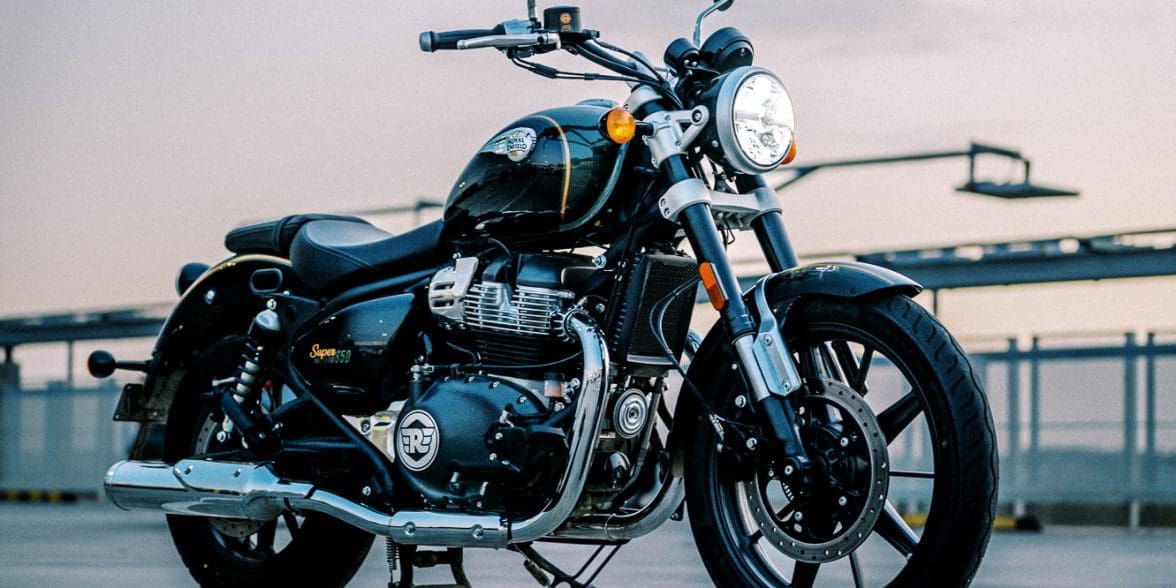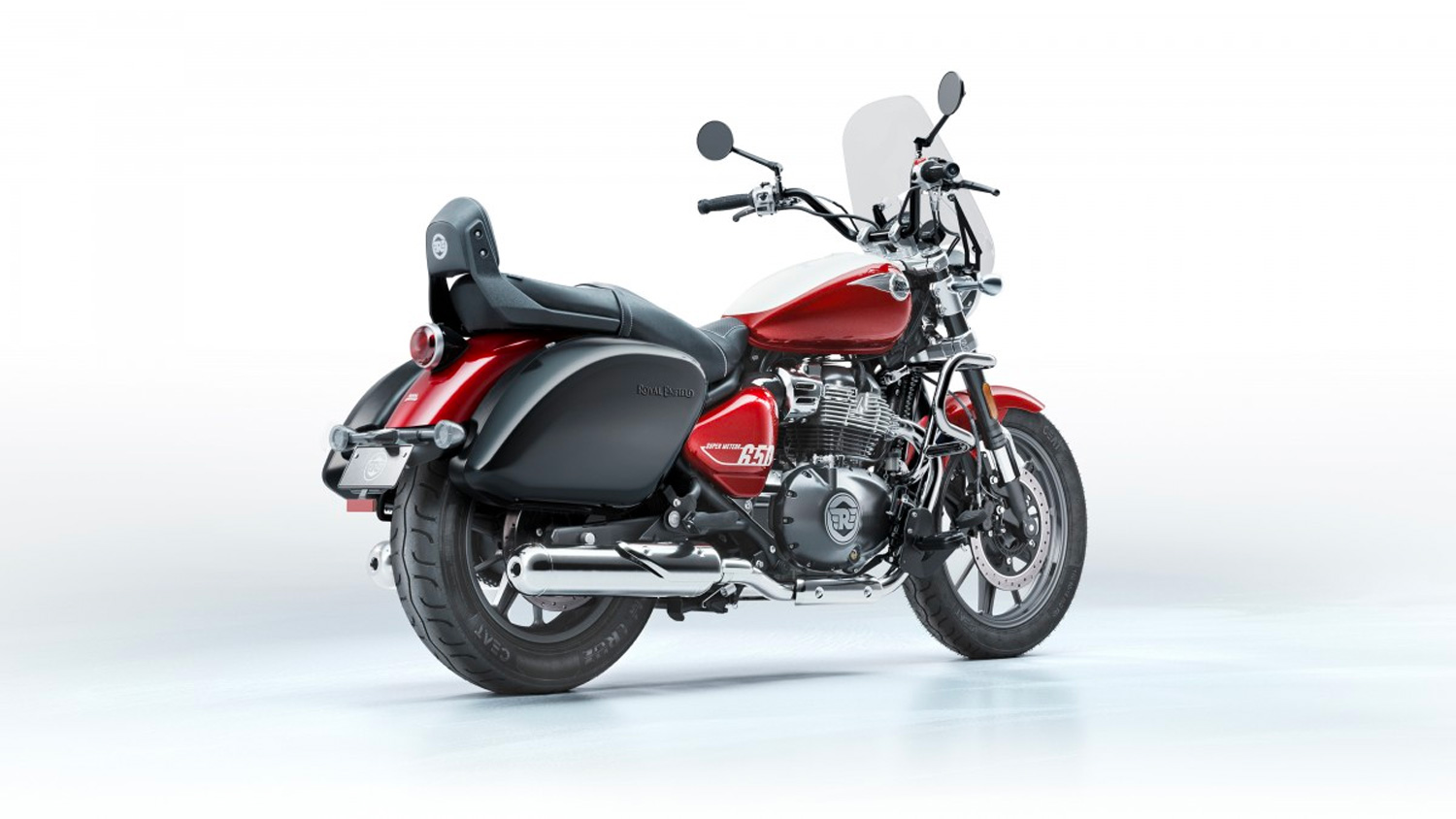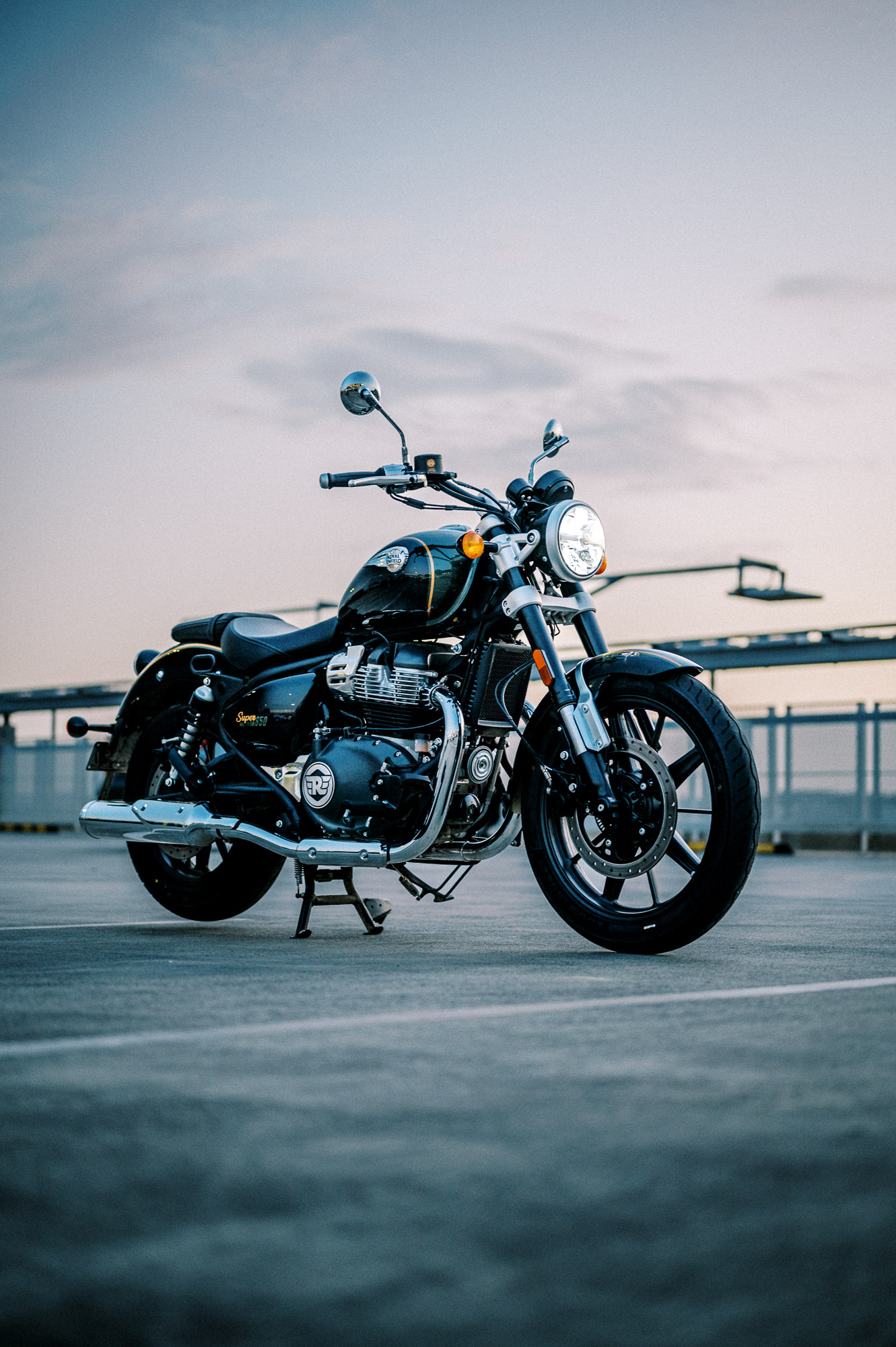Review Summary
- Royal Enfield’s latest motorcycle is arguably also their best-ever and clearly shows their global market ambitions; it’s also pretty damn good
- Based on their 650 twin platform, it’s a 240 kg bike that does retro cruising without pretence and ticks many boxes if you’re after something that’s easy to ride, comfortable and understated
- Thanks to a nicely-sorted rear end, it’ll handle faster corners better than you might expect, but the flip side of this is that it can be a little hard on the kidneys over speed humps and expansion joints
It’s sunset in the Rajasthan desert and I’m perched atop the 860 year old Jaisalmer fort necking a beer. Sucks to be me, yeah? The site is UNESCO World Heritage listed and it looks like it’s been taken straight out of a yet-to-be-made Indiana Jones movie. What really blows me away is that it’s a “living fort,” meaning that after the soldiers and Indian royalty moved out (or were met with a more gruesome ending) the locals moved in. The main thoroughfare quite literally takes you through the fort’s defensive gates and ever upward into the old ruin’s ancient heart. It’s here you will find food vendors, artists, Hindu temples, hotels, stray dogs, smiling school kids, wide-eyed tourists and if you were there in January 2023, a new Royal Enfield motorcycle or twelve.
So if an American cruiser equals a long, straight road in the Californian Desert, a bottle of Coke and a set of leather chaps, what does an Indian cruiser equal? It equals this. India’s very flat, very sandy, very deserted North West. There are as many similarities to California as there are differences. Just swap the Coke for a Chai tea and the leather chaps for a silk sari. This is where Royal Enfield saw fit to reveal their latest – and some would say most ambitious – motorcycle. Realising the futility of trying to take Harley on on their own turf, they pulled the dhurrie rug out from under the cruiser segment and repositioned everything on their home turf and somehow I was invited along for the ride.

Sworn to secrecy, I was also ushered into their UK Tech Centre/secret laboratory and was allowed access to their brand-spanking-new South Indian headquarters in Chennai. And no, I’m not bragging here. Well OK… I kind of am. But I was also working my arse off taking photos and making videos to show the bike’s transition from an idea realised over some Friday beers to what you see here; a new motorcycle that you can buy and ride no matter where you are on the planet. Despite Enfield’s support and kindness in allowing me to tag along for what proved to be a very interesting ride, I’ll (as always) remain objective. I’ll also tell the bike’s story like it is, warts, diamonds and all.
There’s little doubt that this bike is a bold move for the company. Better known for retro singles and cafe racers that look like they could have been made in the 1950s, it reminds me of their push into the off-road segment with the Himalayan in 2015. At first you might be confused as to why they are doing it, but once you look a little deeper into their brand and history it all makes sense. But there’s a distinct difference between a bike that makes sense and a bike that’s worth you handing over a decent chunk of your cash to own. Hell, why would you risk it when there’s other manufacturers out there that have been making cruisers for many, many years? Let’s take a look and find out.
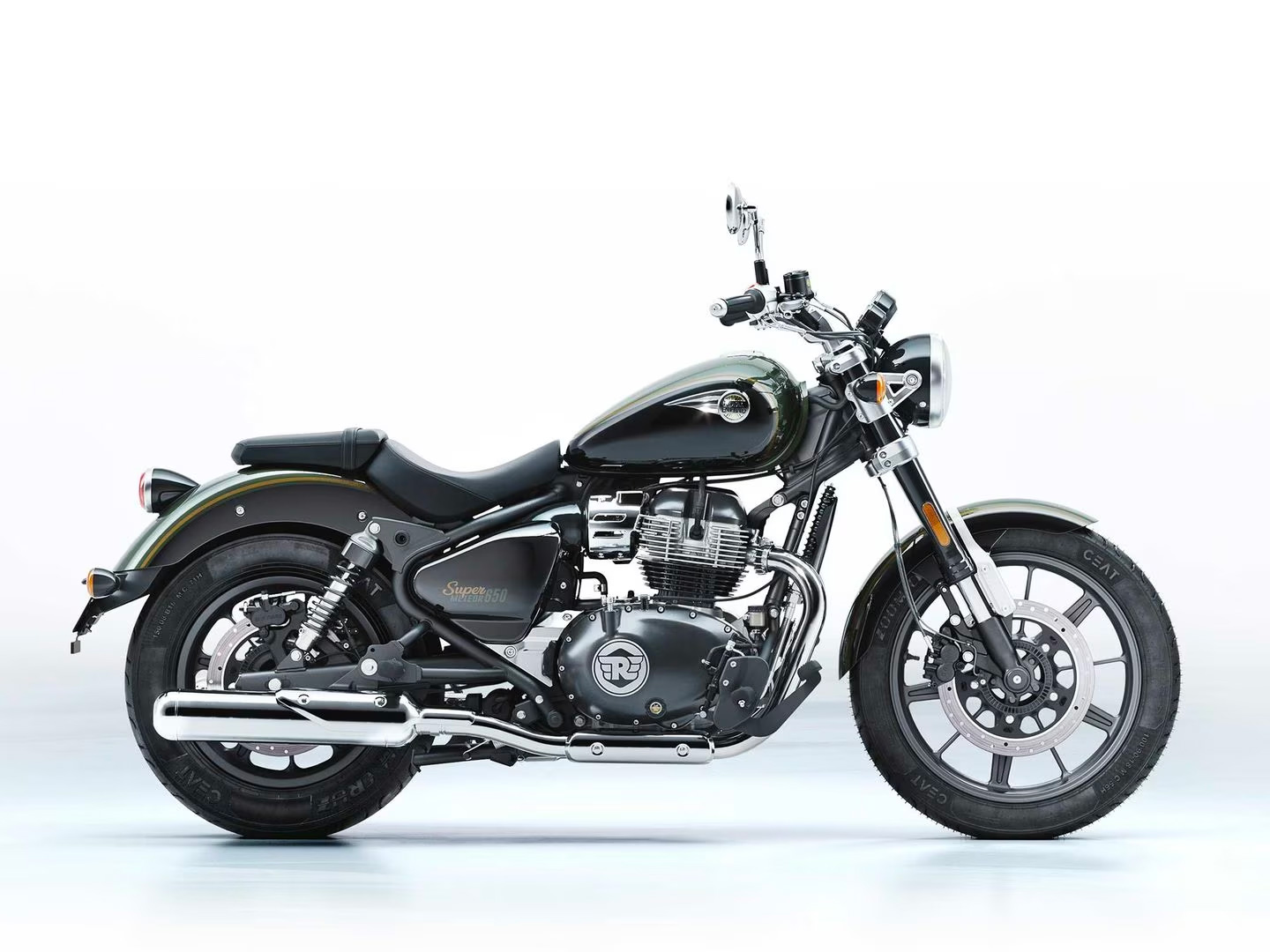
Features of the 2023 Royal Enfield Super Meteor 650 Cruiser
It’d be easy enough for the uninitiated to take a quick look at the new Super Meteor and jump to the conclusion that it’s just a 650 Interceptor or GT with some cruiser bits bolted onto it. But you’d be wrong. Sure, it does share the same basic 648cc, air and oil-cooled parallel twin, but for the most part everything else has changed and even the engine itself has been modded for this less sporty, more relaxed application. Add to this some engineering firsts for the company and it’s probably not the “cheap but basic” bike you may have been expecting.
Engine
The parallel twin runs a 270˚ crank and as a package, it ticks my personal boxes for looks, character and exhaust note. It’s got an overhead cam as you’d expect and backs that up with a well-sorted EFI system, electric start and a wet multi-plate clutch. All very much expected features, no doubt, but this is the same engine that garnered some proper praise after its first appearance 5 years ago including quite a few “best retro” nods for both the 650 platform and the donk itself. If you’re looking for an infinite stable of horsepowers or the necessary torque to tear chunks of asphalt off the road, you’d best look elsewhere. But what It does have is genuine, classic, parallel twin feels and it’s very own character that manages to set it apart from other middleweight cruisers.
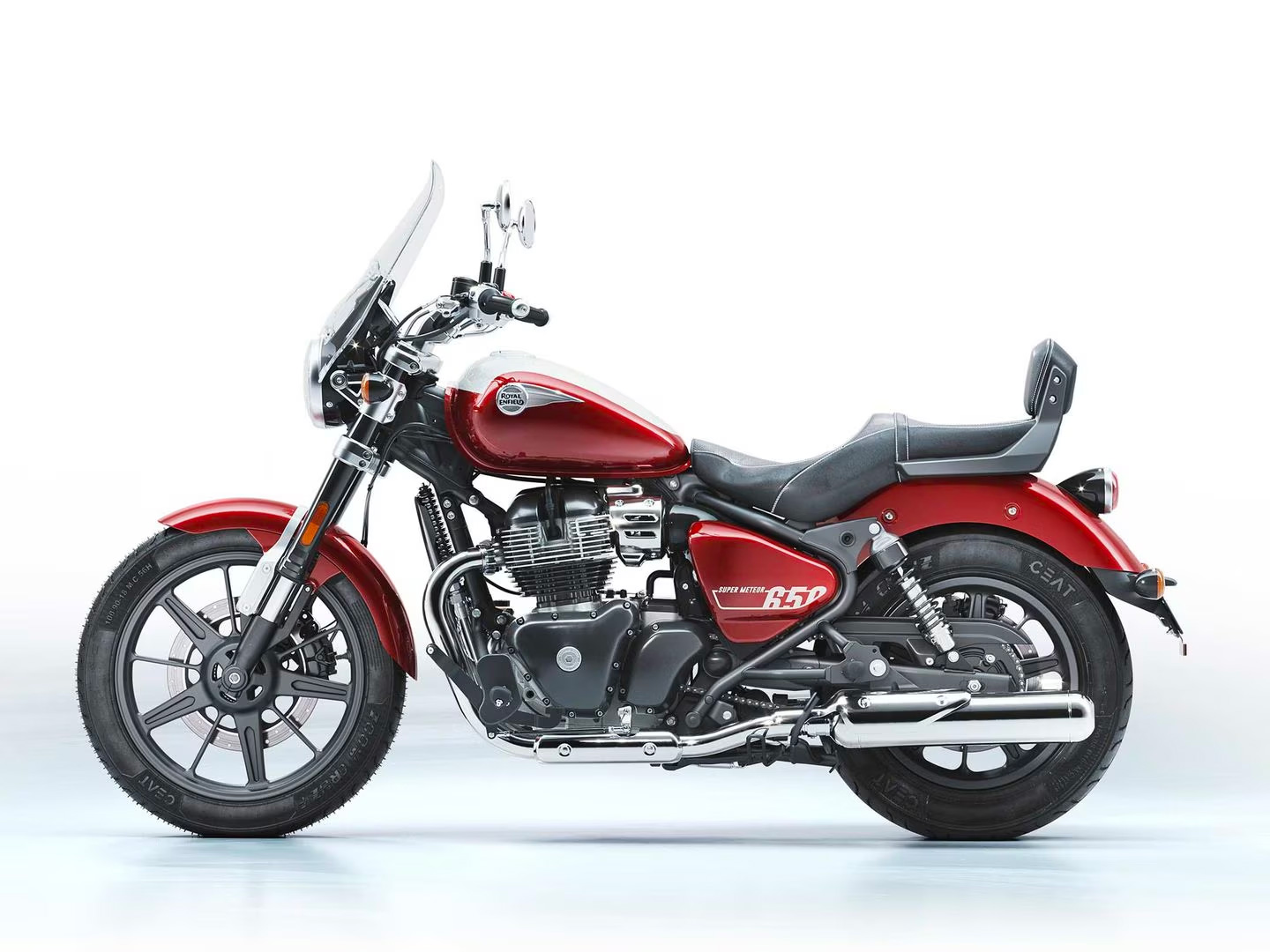
USD Forks
A first for Royal Enfield, the Showa “big piston” upside-down forks were a decision the brand’s UK and Indian engineers made to give the Super Meteor class-leading handling characteristics and to defy the expectation that many may have regarding cruisers being very floaty boats. And while you can be sure they don’t transform the bike into something it’s not, they and the large-ish front tyre give the bike a planted, comfy, relaxed feel without the accompanying “please don’t go around any corners” vibes that you might have expected from an older-style cruiser. In fact, I’d go as far as to say that it kind of likes corners, but more on that later.
LED Headlight
In another brand first, Enfield have included a kind of retro-futuristic LED headlight as standard equipment on the Super Meteor. I’ll be honest here – at first I was thinking that it was a rather strange inclusion on a bike that was clearly so focused on classic design cues and historical references. It felt to me a bit like attaching an iPad to the dash of a ‘59 Cadillac. But I’m happy to admit I was wrong; the light it puts out may be on the cooler end of the spectrum but the design is perfectly executed and manages to gel nicely with the overall aesthetic of the bike. Besides, modern retros are about reviving all the best bits of classic motorcycling and not that annoying crap that came with it like horrible headlights, oil leaks and brake fade.
Other Features
Other niceties of note include Enfield’s “Tripper Pod” Google-powered navigation system, a foot-forward riding position, a very cool-looking instrument cluster, Brembo-made ByBre brakes with a single disc at each end, Bosch ABS, Showa twin rear shocks, USB socket, and Indian-made Ceat rubber. I tested the standard roadster version, but as you can see here, there’s also a tourer version that gives you a screen, better seat and a passenger backrest. Available colours are Astral black, Astral Blue, Interstellar Green (the “hero” colourway), Celestial Blue and Celestial red. Note the “space” theme here. Geddit?!
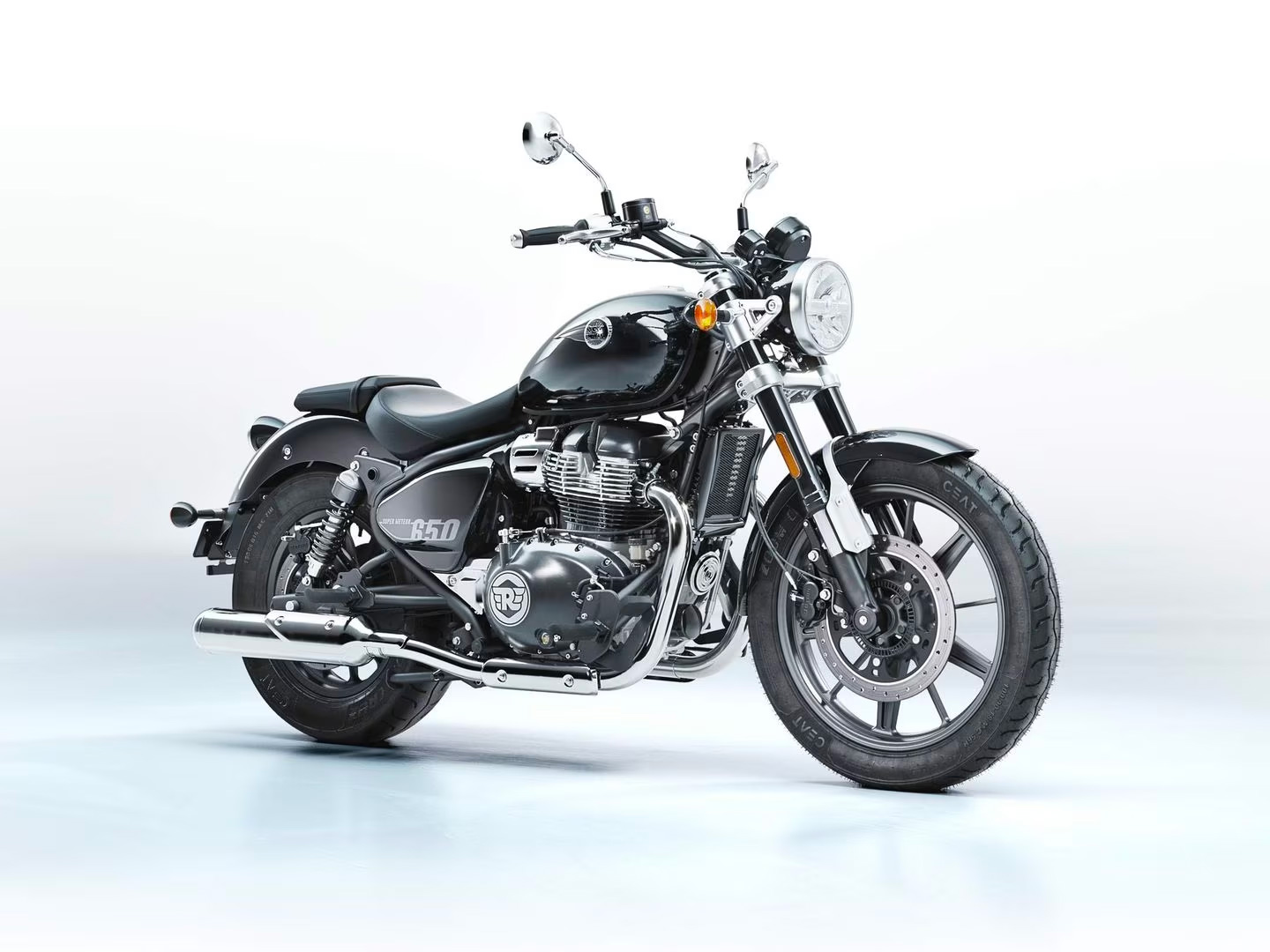
Specs
The engine is a 648cc, twin-cylinder, air/liquid-cooled, four-stroke parallel engine with one overhead chain-driven camshaft. Compression is a restrained 9.5:1. It puts out a decent 47 PS @ 7250 rpm and 52.3 Nm @ 5650 rpm with petroleum piped from a 15.7 ltr (4.1 gal) tank. The stock bike weighs in at a substantial 241 kgs (531 lbs) and the seat height is a slightly taller than expected 740mm (29 in) when compared to other bikes in the middleweight cruiser segment. The bike is shod at the factory with tubeless Ceat Zoom Cruise ZFs tyres, with a 100/90 – 19 M/C 57H on the front and a 150/80 B16 M/C 71H out back.
Initial Impressions of the 2023 Royal Enfield Super Meteor 650 Cruiser
The weird thing about my whole experience of the Super Meteor is that unlike pretty much every other bike I’ve ever reviewed, I saw the Super Meteor “grow up”, so to speak. I saw it as a clay model at the company’s UK tech centre. Then I saw it as a weird, handmade experiment as it ran laps around Enfield’s British Midlands test track at Bruntingthorpe. I saw it yet again as a matt black, pre-production bike that was intended to test the Chennai factory’s production capabilities and ensure that when they went into full “go” mode, the end result wouldn’t be a bunch of poorly-made rubbish but instead that each and every bike that came off the end of the automating line would be made to the same standard. Compare and contrast that to my usual experience of being given a finished bike and not knowing diddly squat about it, bar what I’ve read the day before on the company website.
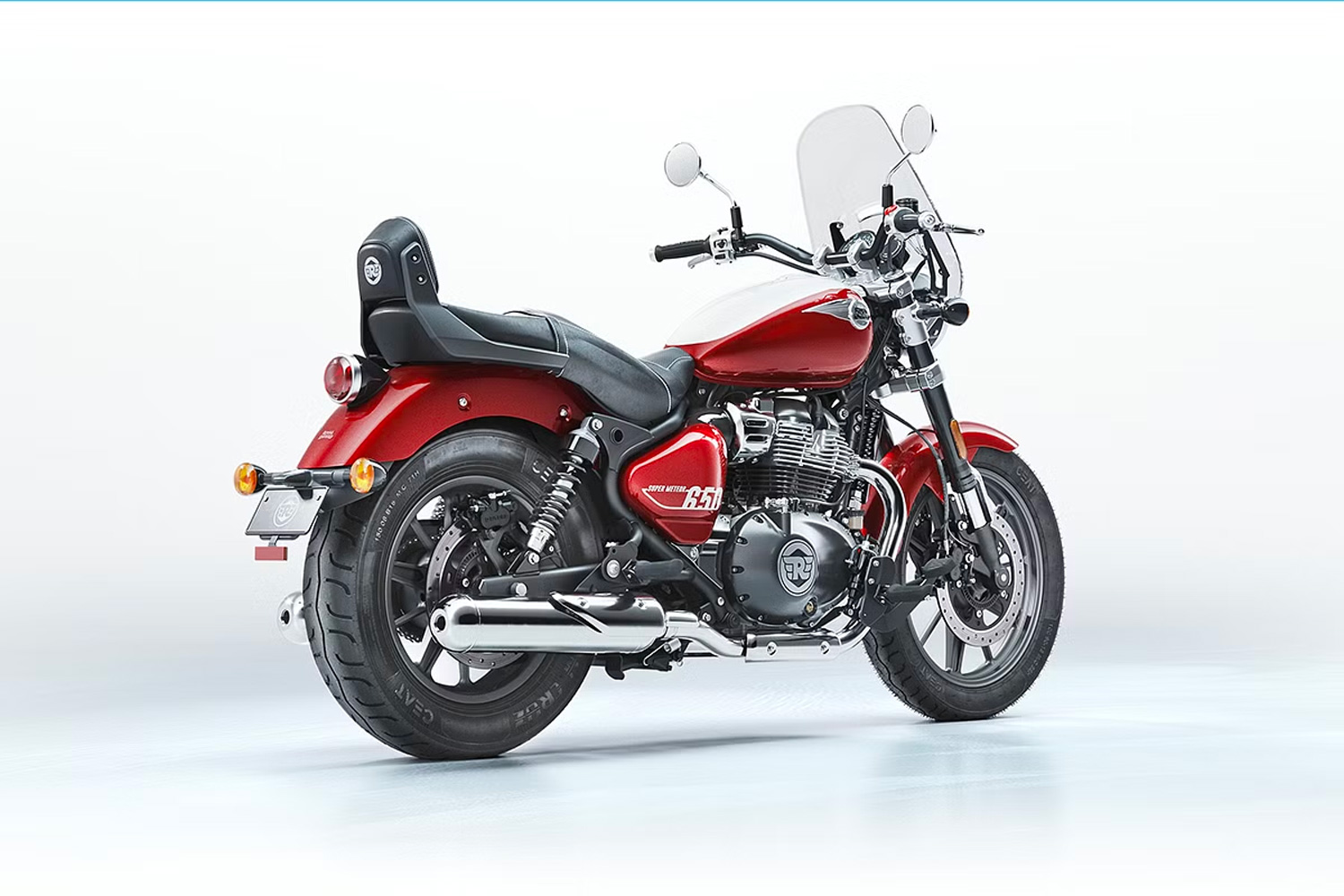
All Work, No Play
So by the time I got to ride the bike for myself, I felt I knew more about the Super Meteor than pretty much anyone outside of the company itself. But the glaringly obvious fly in this otherwise fine ointment was that I’d still not properly ridden the thing yet. Even my time in Rajasthan was wall-to-wall with taking photos and making sure that the crew I was embedded with got the shots, interviews and footage they needed. Riding the bike was something to do in my downtime, and unsurprisingly there’s not much downtime to lollygag around and ride motorcycles when you’re on the clock for a global motorcycle manufacturer. What a cruel, cruel world. Besides, when a bike’s very existence is one big secret, it’s not like you can just grab one and ride it down to the local shops.
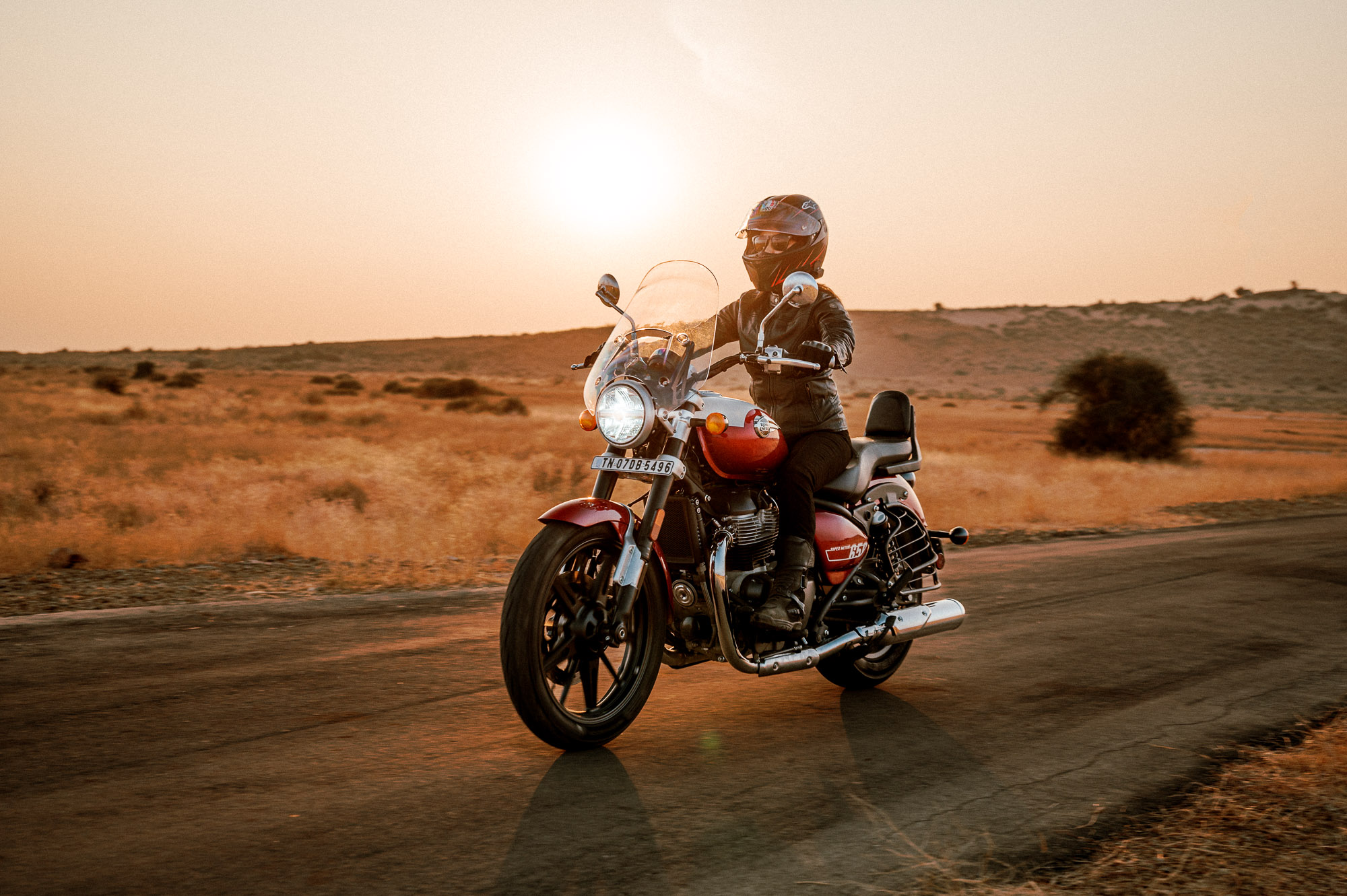
But soon I tired of all the teasing and I put my rather stinky, leather-booted foot down. It was time to ride the thing. I couldn’t wait any longer. I’d even twiddled my thumbs while Royal Enfield Australia did a local launch. Fast forward to last week and I jumped out of an Uber and onto the front lawn of a Sydney-based journo who’d just finished up riding it for himself. Shekar, my Bangalore-born Uber driver who’d taken me to the bike’s location was so excited by my story of an unreleased Royal Enfield he’d never seen before, he parked his car and followed me up the driveway to check it out. In the darkness of a late Autumn Sydney evening he and I both laid our eyes on it. For me, it was like seeing an old friend again, but for him it was clearly a mix of national pride and a kind of special treatment that he’ll no doubt be bragging about to his family in no time flat.
Less is More
Used to Enfields (at least recent Enfields) being on the smaller, lighter side of things, the first fact you’ll notice when seeing the Super Meteor in the metallic flesh is that it’s a substantial bike. Not like a Harley Road King or a Victory Vision, of course. But even next to the other 650 twins in Enfield’s lineup it has a decent presence. Especially in its touring guise. A tall screen and a passenger backrest will do that to a bike. Having jumped straight off of a BMW R 1250 RS, the other big contrast perusing the Super Meteor is how clean and simple it is. No, it’s not barebones. It’s more a case of everything in its right place. Enfield talk at length about “pure motorcycling.” And sure, you always have to be careful when engaging with marketing speak, but what it means here is that they went to great lengths not to get in the way of the rider’s enjoyment of their bikes.
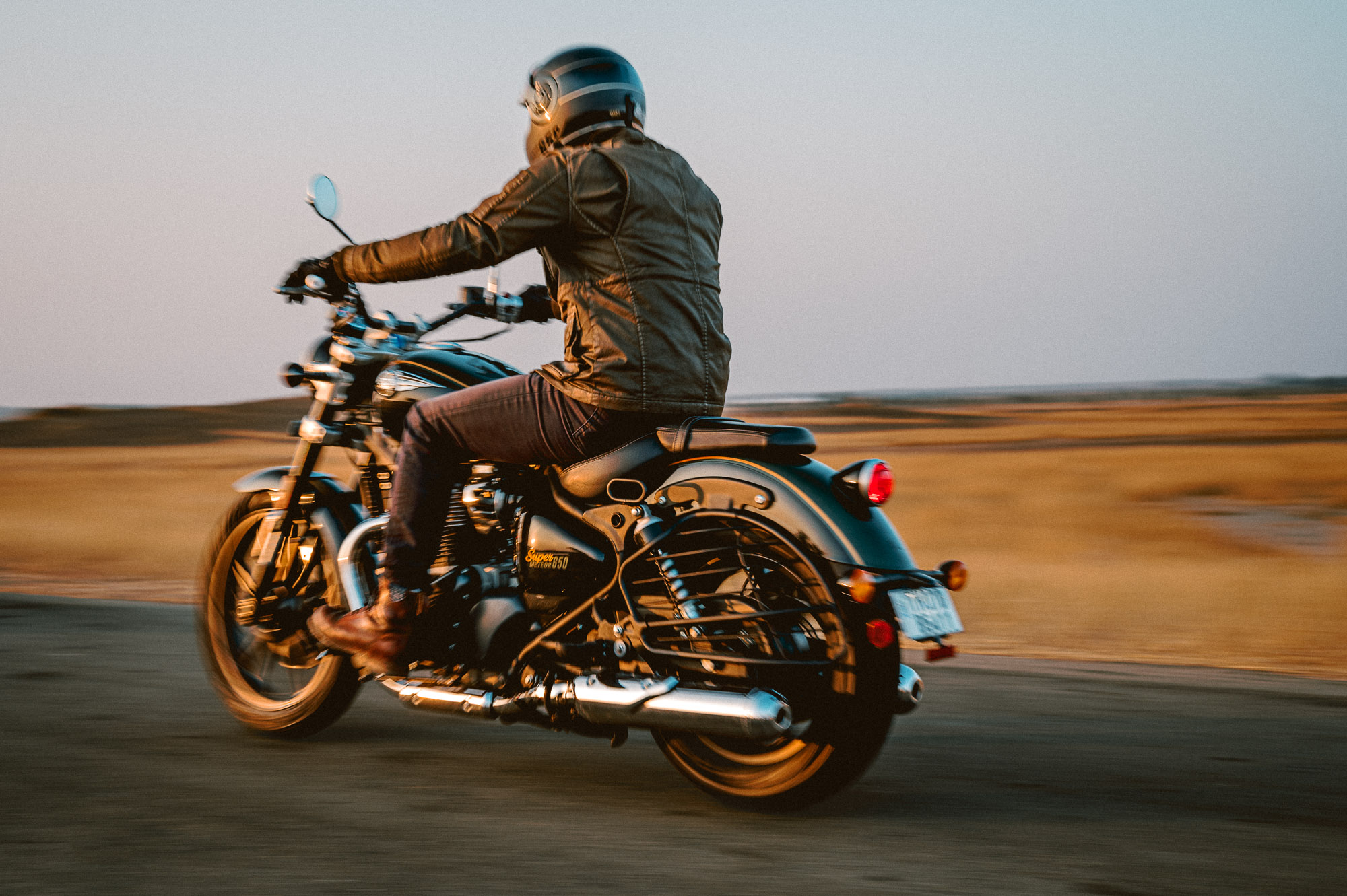
So when they signed off on the LED headlights, USD forks, the Tripper Pod and all the other little touches that makes the Super Meteor what it is, their guiding principle was to enhance the owner’s experience and not interrupt it. And being the company’s first proper cruiser in a very long time, it strikes me as a sensible angle of attack. Why re-enter the segment with all flash and no substance? Given cruisers can be a little gaudy (to say the least); the choice to bring a clean, functional and humble-feeling bike as an initial offer strikes me as a smart move indeed.
With that said, the bike’s switchgear and metal surrounds have clearly had more than their fair share of design limelight shone on them. Hell, someone’s gone to town here. With aluminium instead of the ubiquitous plastic casings, they feel like a step above pretty much anything I’ve seen Enfield do before. And the frosted metal theme carries through to the bike’s top triple, bar clamps and fork ends too. Finished in a lovely matte anodising, the overall effect is one of solidity and cleanliness. But the literal gilding on the lily here is the Meteor’s tank badge. Sure, a simple transfer or painted logo could have saved you a few bucks at the dealership, but instead they’ve gone for what probably constitutes one of the nicest badges I’ve seen in ages.
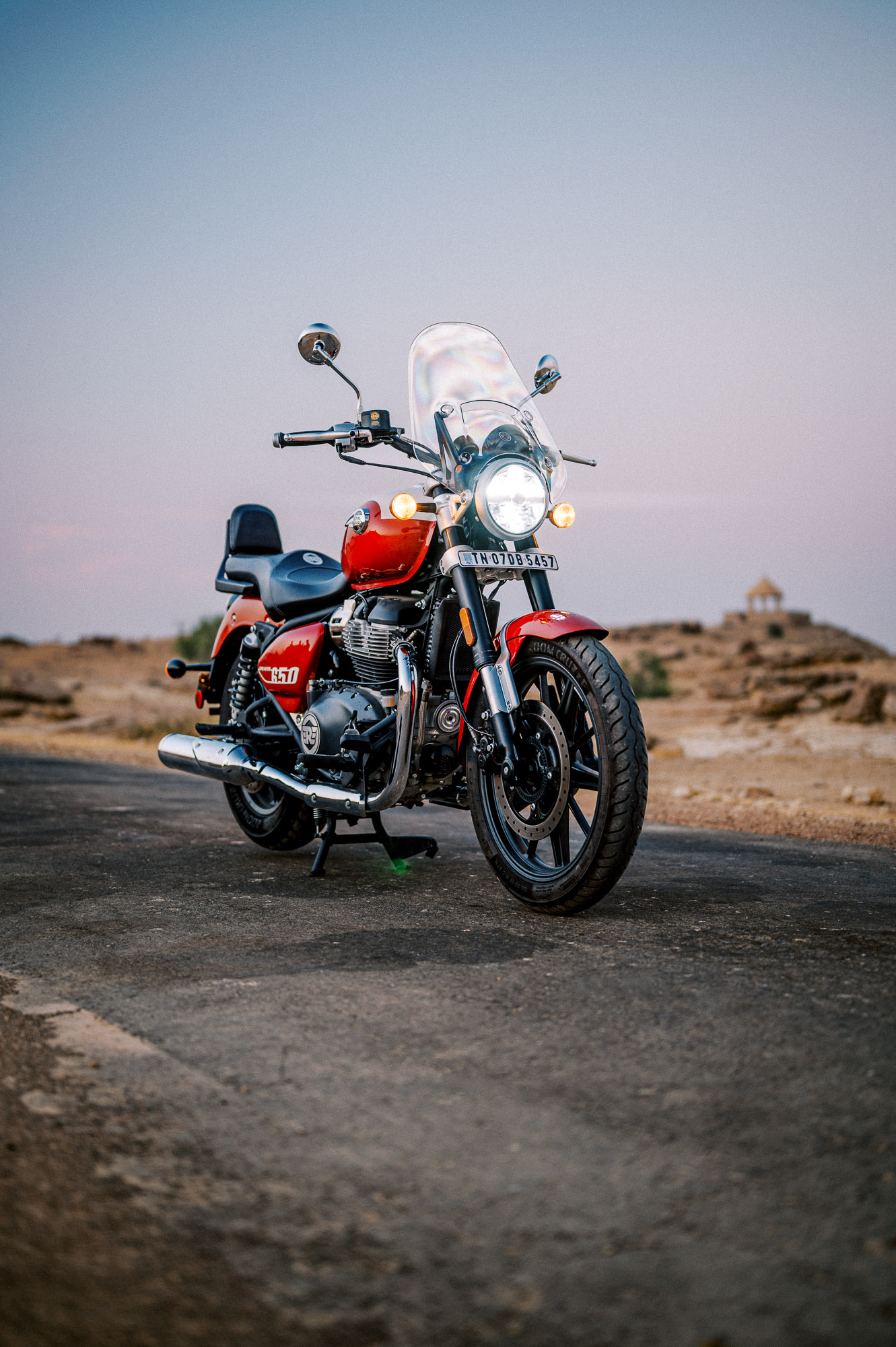
Riding the 2023 Royal Enfield Super Meteor 650 Cruiser
Riding in the City
In another upside-downing of my usual plans, my first proper time in the Super meteor’s saddle was at night. It was as if the motorcycling gods were rubbing it in my face. Sure. I’ll test the headlight out. Who needs daylight anyway? So from one side of Sydney to the other I rode, with nothing but these new-fangled light emitting diodes to brighten my way. As with many modern LEDs, the headlight’s upper “cut off” line is sharp and a little brutal at first. None of this fuzzy pool of warm tungsten light to guide me. The Meteor’s LED throws an almost perfect semi-circle of light at the road with nothing pure but darkness outside of this clearly-defined pool.
The riding position is more than a little slouchy and relaxed; not only is the bike all-day comfortable, but the whole foot-forward, relaxed shoulders position gets you into the mood that most suits riding a cruiser like this. It’s unhurried. It’s got a little ‘tude. It makes you smile. And you’ll need to retain your feet’s muscle memory as they lift up from a stop at the lights and move to the non-existent pegs that are about 20 cm back from the real ones. Note to self – accidentally putting your feet down while a motorcycle is doing anything above 10 km/h is very much a bad idea.
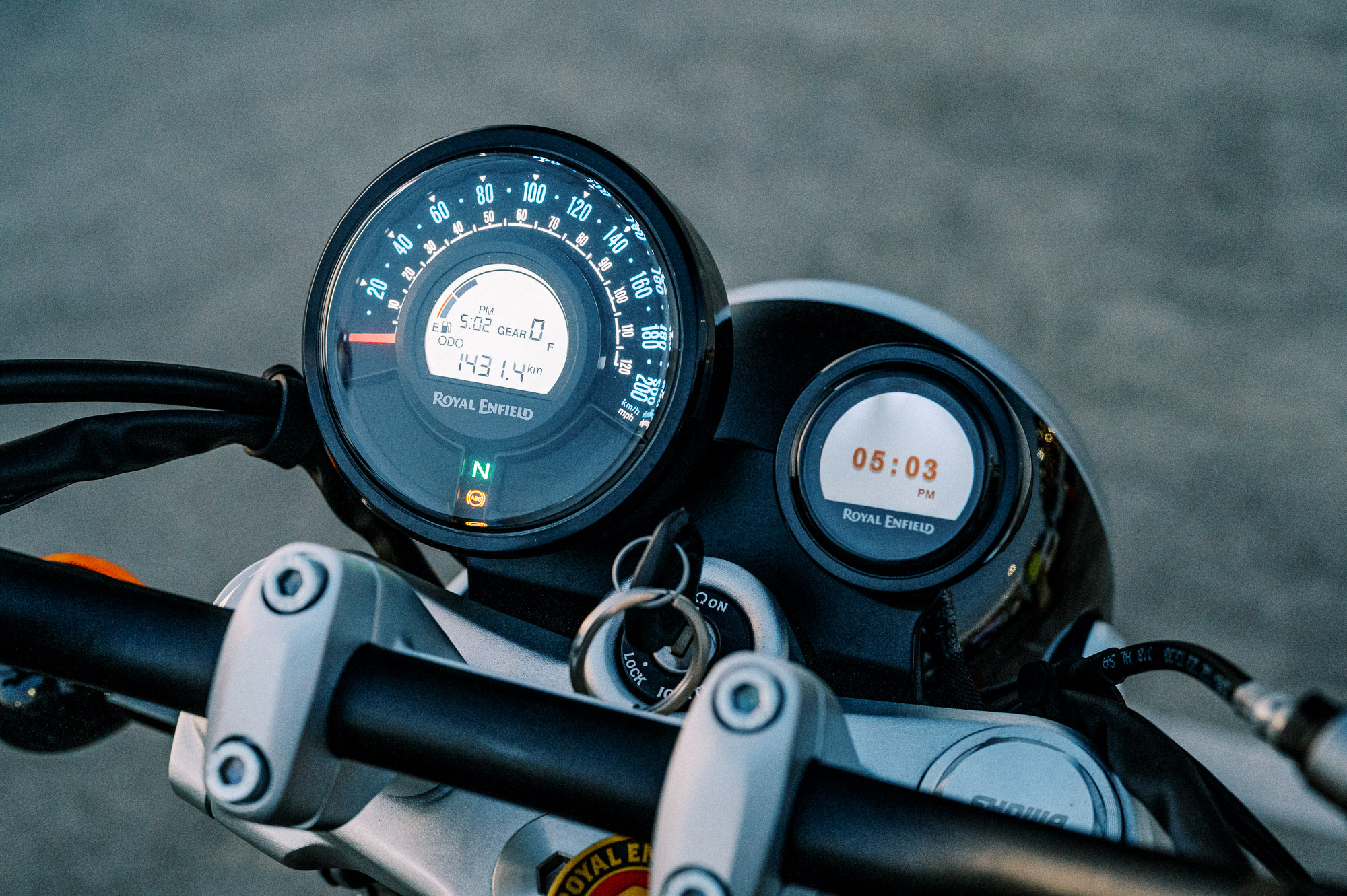
But once your muscles have re-memoried, and your feet are ending up where they are supposed to go, the bike comes into its own. With a badarse posture and the subsequent smile that it puts on your face, you end up just cruising around the place knowing that the bike is there and doing its job. Nothing less and nothing more. I try and connect to the Tripper Pod, but the Royal Enfield app asks me to log in and – of course – I can’t remember my username and password. Nor does my phone. I’ll apologise in advance to the regular readers of these reviews, but to all the manufacturers out there; we don’t need more apps on our phones. Especially ones that replicate things like Google or Apple maps. Yes, I know you want to connect with your customers, but for the Moto God’s sake, tedious apps that feel like they are years out of date technically aren’t the way to do it. Note to self: try the Tripped Pod at a later date.
Breathing deeply to stave off any latent app frustrations, I get back on the road and again settle into the gentle cruising and the warm burble emanating from the Super Meteor’s twin sausage pipes. It sure is a nice tune. Bassy and warm like an old analogue synthesiser, it’s always set to the correct volume and never becomes tiresome. After an hour or two of gangster slouching ala Sons of Anarchy, I can feel a slight ache in my lower back. Follow-up rides proved that it wasn’t an issue of concern, but for those out there that are more used to an upright or slightly forward-leaning riding position, your skeleton may take a little time to adjust to your spine’s new c-shaped bend. Running over expansion joints in the road at low speed brings the stiffness of the rear shocks into stark contrast; the front crosses with a dull bump while the rear wheel’s sharp pop makes me think either a) the rear shocks are pretty damn stiff or b) the rear tyre is over inflated. I checked it. It isn’t.
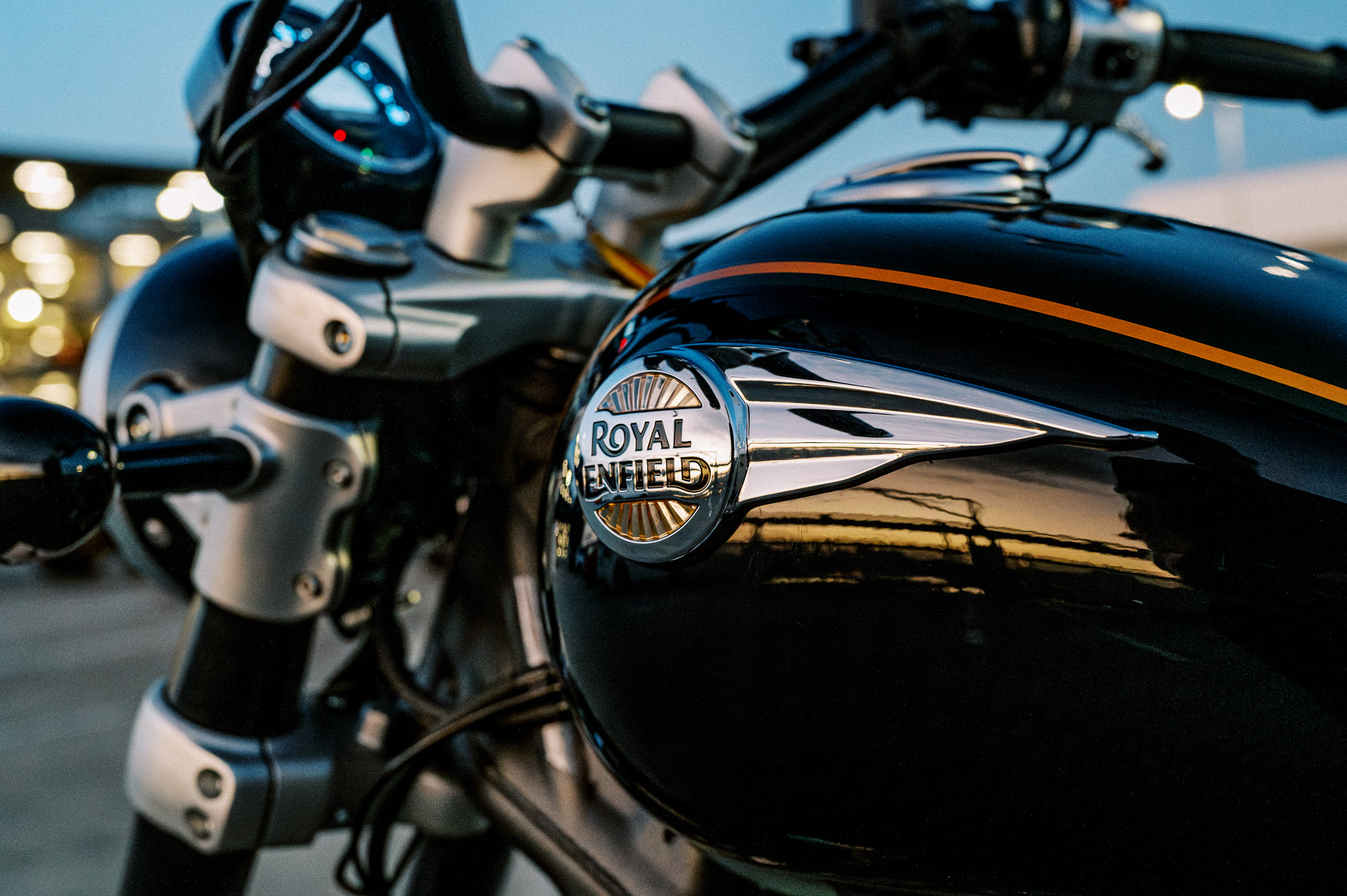
All the bike’s instruments are contained inside the large, retro dial placed to the left of the Tripper Pod. It’s a nicely thought out unit with just enough retro to make it cool while ensuring that it won’t look naff in a decade. With a needle that sweeps from 8 to 4 o’clock to show speed, there’s a centrally place and backlit LCD screen to display time, gear, fuel, odometer and a little “eco” indicator which I assume is a simple manifold vacuum sensor to tell you when your right hand is hurting the planet. The tripper pod has a day/night mode which seemed to know when to switch without any blinding and/or squinting required at dusk.
As with the Scram 411 I recently borrowed, the Tripper Pod displays the time when it’s not being actively used to display directions. The fact that the time is also displayed on the larger dial to its immediate left isn’t a major issue, but I’ve noticed on both the Scram and here on the Super Meteor that it can show different times if you don’t manually set them to match. This makes me think that some corners were cut and that maybe they should have taken the, erm, time to either mod the Tripper Pod to shut down when it’s not displaying nav instructions or to delete the time from the main display.
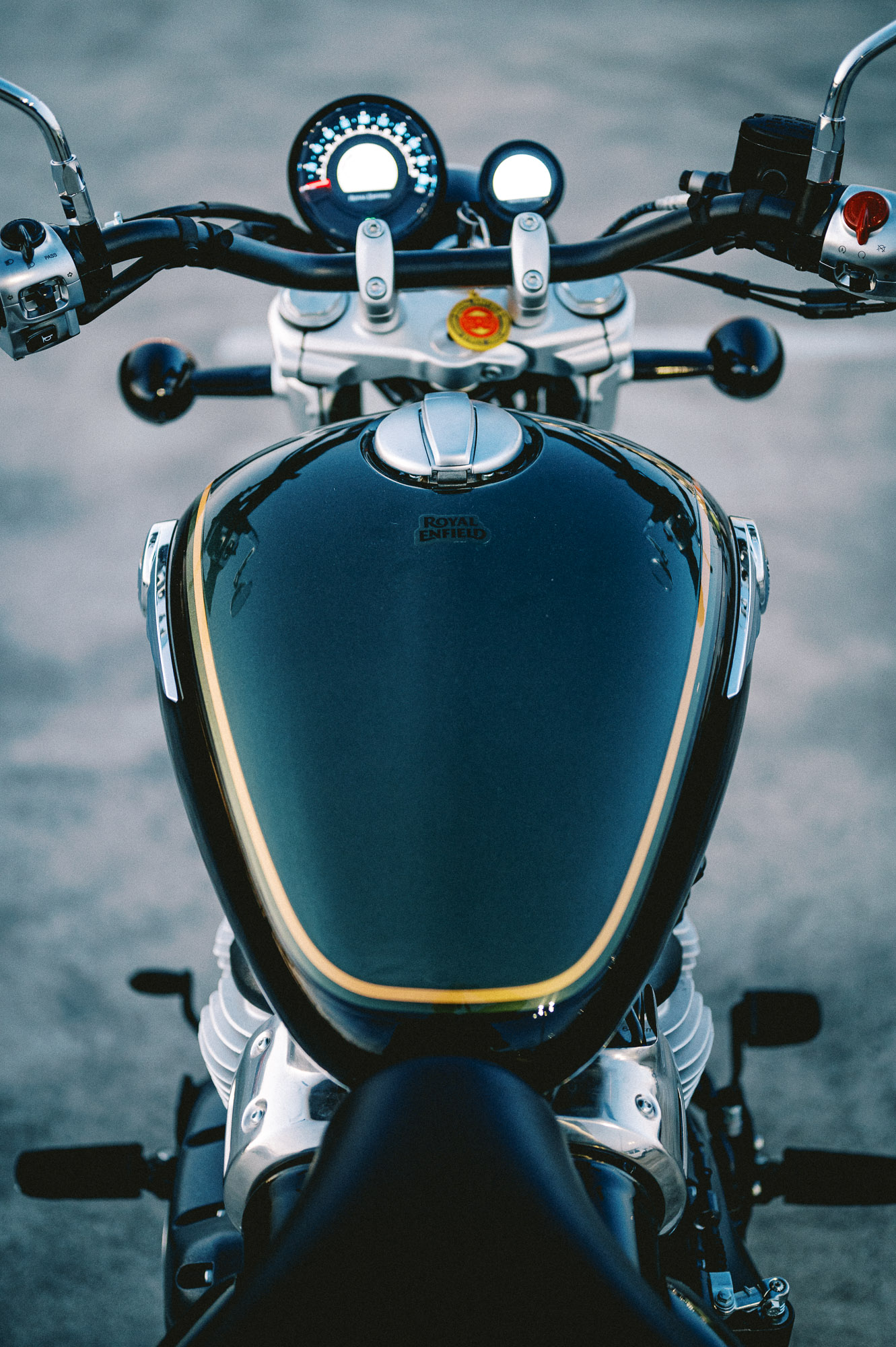
Fussy details aside, the bike’s a charmer around town and on the inner city freeways. Sure the “cruiser” name tag might suggest that it’s going to be most comfortable on sunset desert freeways as you glide past overweight patrons struggling to get into their SUVs while carrying armfuls of burgers and shakes but the reality is that like most bikes, Super Meteor’s will mostly be ridden in cities and suburbs. With more low-down torque than the Interceptor or GT thanks to breathing and engine management tweaks, the bike just gets on with it and feels at home in urban traffic rather than the “antsy racehorse” vibes you can get from bigger, more highly strung bikes.
Riding in the Curves
Having a cruiser that didn’t suck arse in the corners was always at the top of the list for the Enfield designers and engineers. It’s long been the butt of many jokes in the segment; mostly thanks to America’s riding expectations and the architecture of their highway system. When 90% of your Sunday ride is on a straight road going 70 mph, why would you worry about corner handling? But as with all Enfield bikes, there’s an unwritten rule that anything they make must be able to handle Indian conditions along with American highways and a broad cross section of other global roads. Yes, there are long, straight roads in India, but for the most part they are more likely to be urban roads covered in traffic chaos, stray dogs, sacred cows, and about 100,000 local pedestrians. So the last thing they’d want to unleash in conditions like these would be a 300 kg, 140 hp monster cruiser with the turning circle of a particularly large planet.
So when you read this review and think to yourself, “why did Royal Enfield decide to do that?” there’s a good chance that at least part of the answer will be, “because India”. But as I ride through some forested corners south of Sydney’s urban sprawl, what really matters is how the bike behaves right here, right now. Knowing how the rear of the bike performed around town and feeling its decidedly firm response to speed bumps and other road imperfections, I had the sneaking suspicion that it wasn’t going to be as soft or wallowy as you might assume. And it wasn’t.
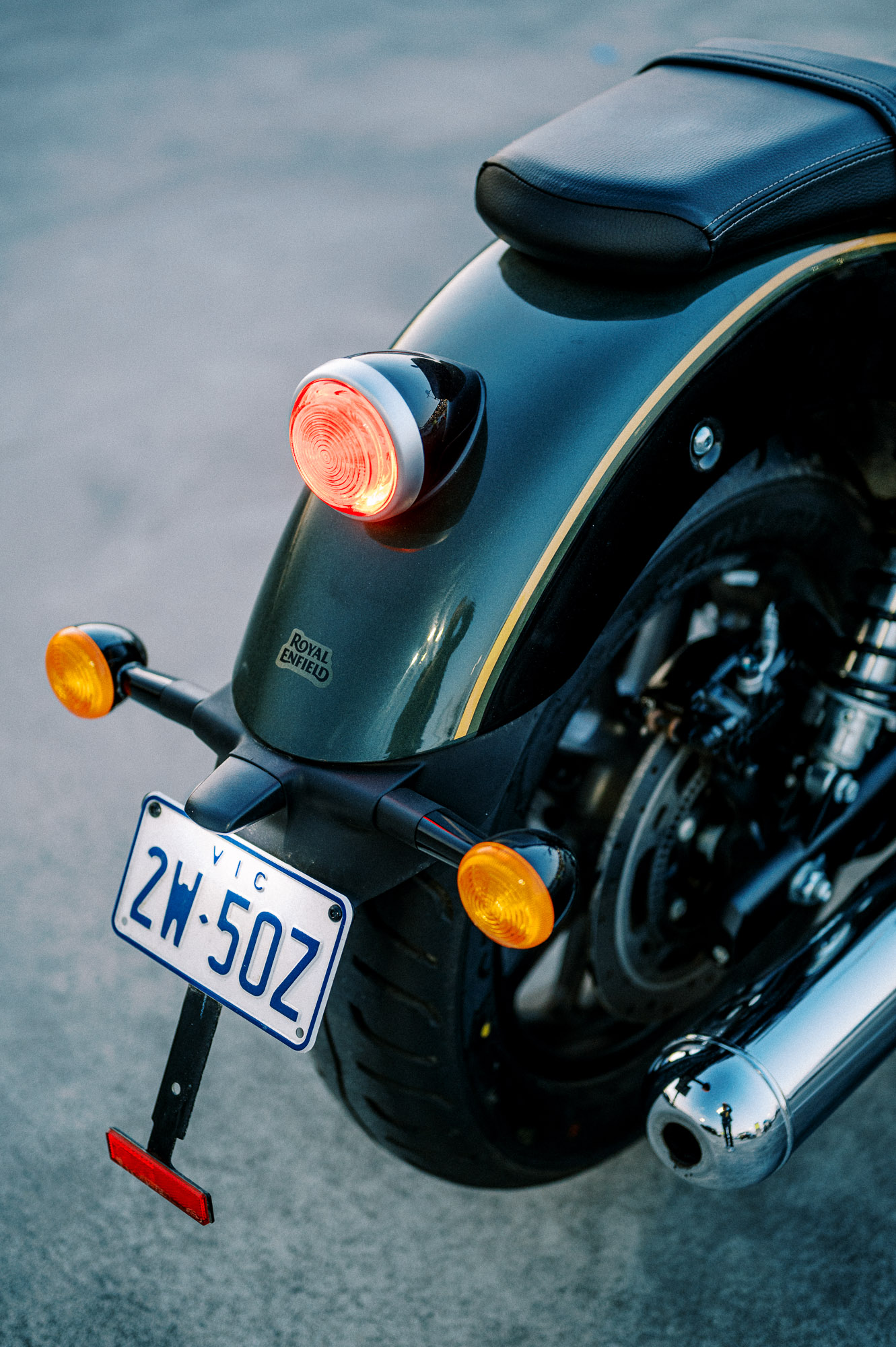
Even when pushed, the bike tracked steadily and with a confidence as I threw it through a series of 80 kmh corners. Easy as that. But there is a safety valve of sorts that makes sure things can’t get too hairy. And that’s the pegs. I’m far from a mad-for it, knee-down kind of rider, but as I upped the speed I managed to get a scrape out of the right peg – and that’s coming from a rider who prefers southpaw corners. So even the most committed rider will only have a tightly fixed window of lean, speed and cornering variables to play with. Welcome to the world of cruisers.
Meteorite Fuel
With the bike throwing up a low fuel warning light at me, I take a quick detour to an enroute petrol station to brim the tank. 11 ltr (3 gal) later I return the filler to its cradle and do some quick maths. With 15.7 lt inside when fully fuelled, the bike gave me the warning with about six litres left in the tank. This feels a little premature to me, especially considering that it sips liquid dinos at quite a reasonable rate. With that said, I might have leant the thing over enough to trip a sensor too. But the takeaway is one of a bike who’s relatively humble specs also afford the owner some very good running costs. And with only the very basic tech included with the bike from the factory, chances are you’ll also be avoiding quite a few electronic dealer adjustments and service peculiarities, too.
It’s only a short stretch of road between the end of the rainforest and the scenic cafe on my test route, but it’s also where you see the mighty Pacific ocean that rocks and rolls off of Sydney to her heart’s content. It’s also a highly policed piece of tarmac, so I’ve learnt over many years to make properly sure that I don’t carry any excitement from the twisties through to here. And hey presto, there’s the cop in his usual hidey-hole. But for now I don’t really care, because I’ve instantly gone back into cruising mode. Thanks to the big blue sky, 180 degrees of ocean and the gentle breeze dividing the two, I’m again slouching and riding the Super Meteor as I feel Royal Enfield intended. If I was to unknowingly ride through a wormhole right now and reappear on some endless coastal road that had the same weather and conditions as I was experiencing right now, I’d be more than happy to ride off into the distance with a smile on my face and head full of nothing but parallel twin rumble.
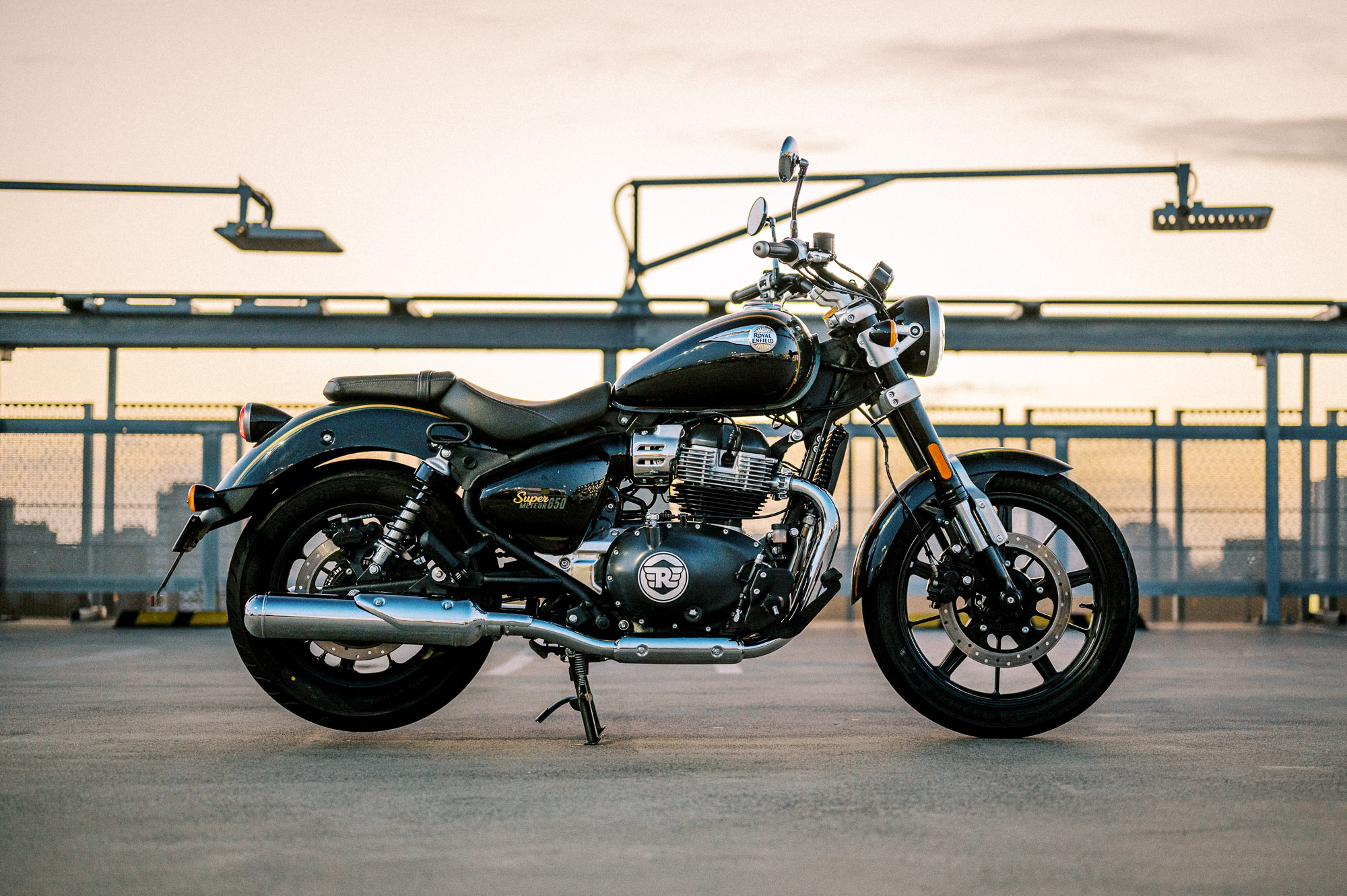
Thanks mostly to the fact that the bike hasn’t been unreleased here in Australia yet, it did attract the odd carpark gawker or three. With most seeming to be cruiser riders themselves, their opening gambits varied from a “what is it?” to a “Oh, I’ve heard about this,” and a “Is it a twin or a single cylinder?” But the conversations all seemed to end in the exact same way. “It’s impressive how fast Royal Enfield have been moving lately, isn’t it?” And it’s true when you think about it. Ten years ago, they were an oddity that only appealed to Indian locals and to Western riders who were committed to an authentic, retro motorcycle experience, even if that came with a surprisingly low top speed and suspension technology that hadn’t really changed in 50 years.
The final leg of my trip included a decent stretch of 110 kmh highway that also had some proper rises and falls along with plenty of long, full speed curves. While the Meteor did require some throttle-based encouragement to tackle it, at no point did I find the bike struggling or feeling like it wasn’t happy. With only 39 lb-ft of torque to play with, this is par for the course I’d suggest. The silver lining here is the inclusions of a 6th gear that does come in handy to reduce revs on long, fast straights. It also allows 5th gear to be more useful and usable on stretches of road like this, ensuring that you don’t get that annoying “4th is too low but 5th is too tall” riding experience.
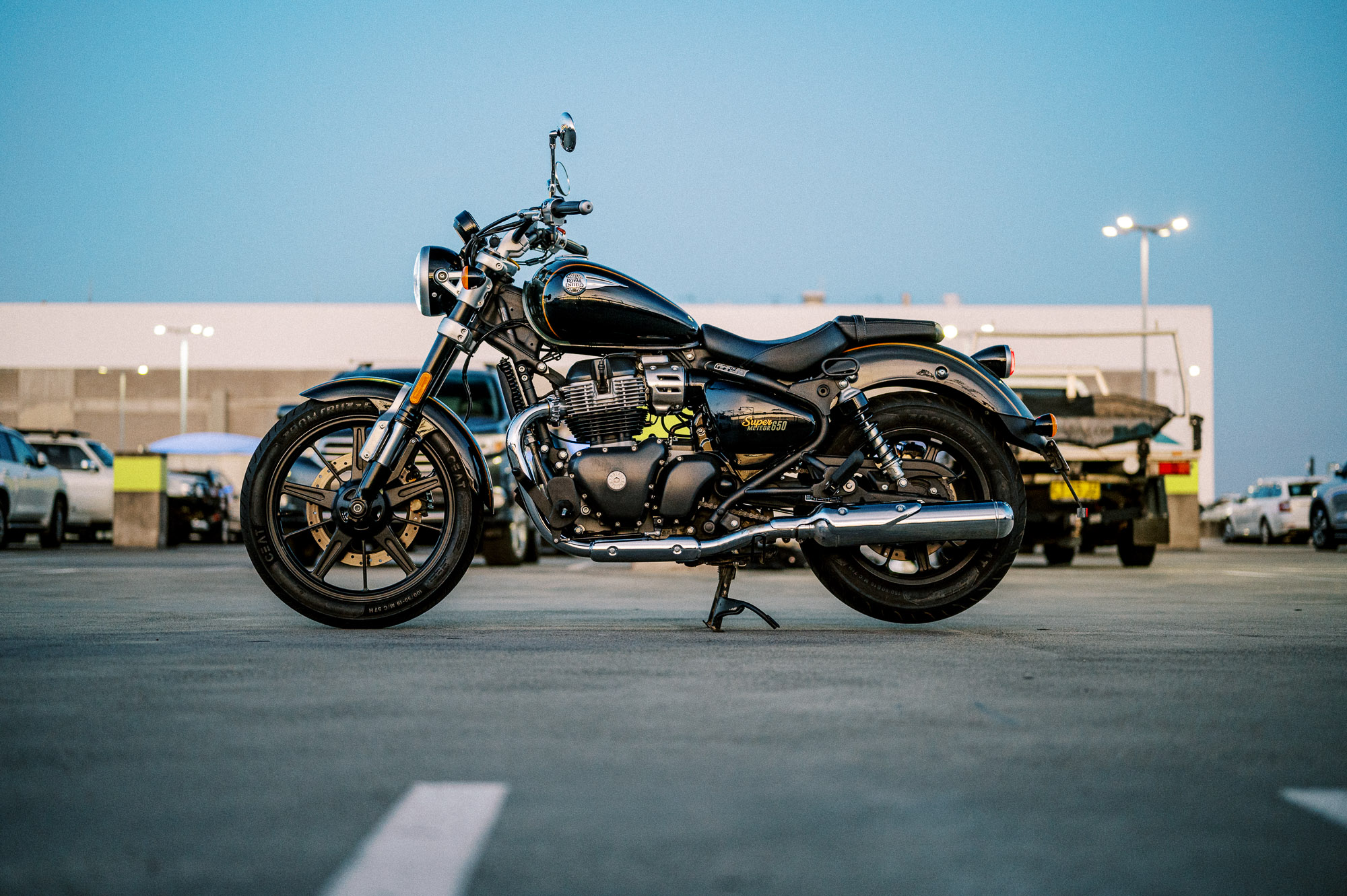
What Could Be Better on the 2023 Royal Enfield Super Meteor 650 Cruiser
With each new bike they release, Enfield are getting better and better at what they do. Bikes like the Super Meteor and the previous 650 twins will no doubt have Triumph and Harley looking over their shoulders. And the rest, too. I see many riders and even some journos making the same mistakes over and over again with their Enfield reviews; they either don’t compare apples with apples or they are too set in their views on Royal Enfield that were more often than not etched into their brains decades ago. If you look at the price of the Super Meteor, remember that it’s around half the price of something similar from another British or American manufacturer; they make a very convincing argument.
I found absolutely nothing that was properly flawed on the bike; instead I think many of my expectations were pleasantly exceeded. But with that said, I have to have some thoughts, don’t I? With an extra 20-something kilos over the other 650 Twin-powered Enfields, the Super Meteor isn’t a lightweight by any means. Personally, I would have liked it to be 20 kgs lighter or to have another 20 hp to play with, but it’s perfectly fine as is. Part from that, the only other concern I had was that the rear shock did make me go “oomph” at times, especially over short, sharp bumps like car park speed humps and the like. But of the trade-off here is a bike that can slice through corners without the rear end turning into a wobbly bowl of Indian rice pudding, then I’m a happy biker.
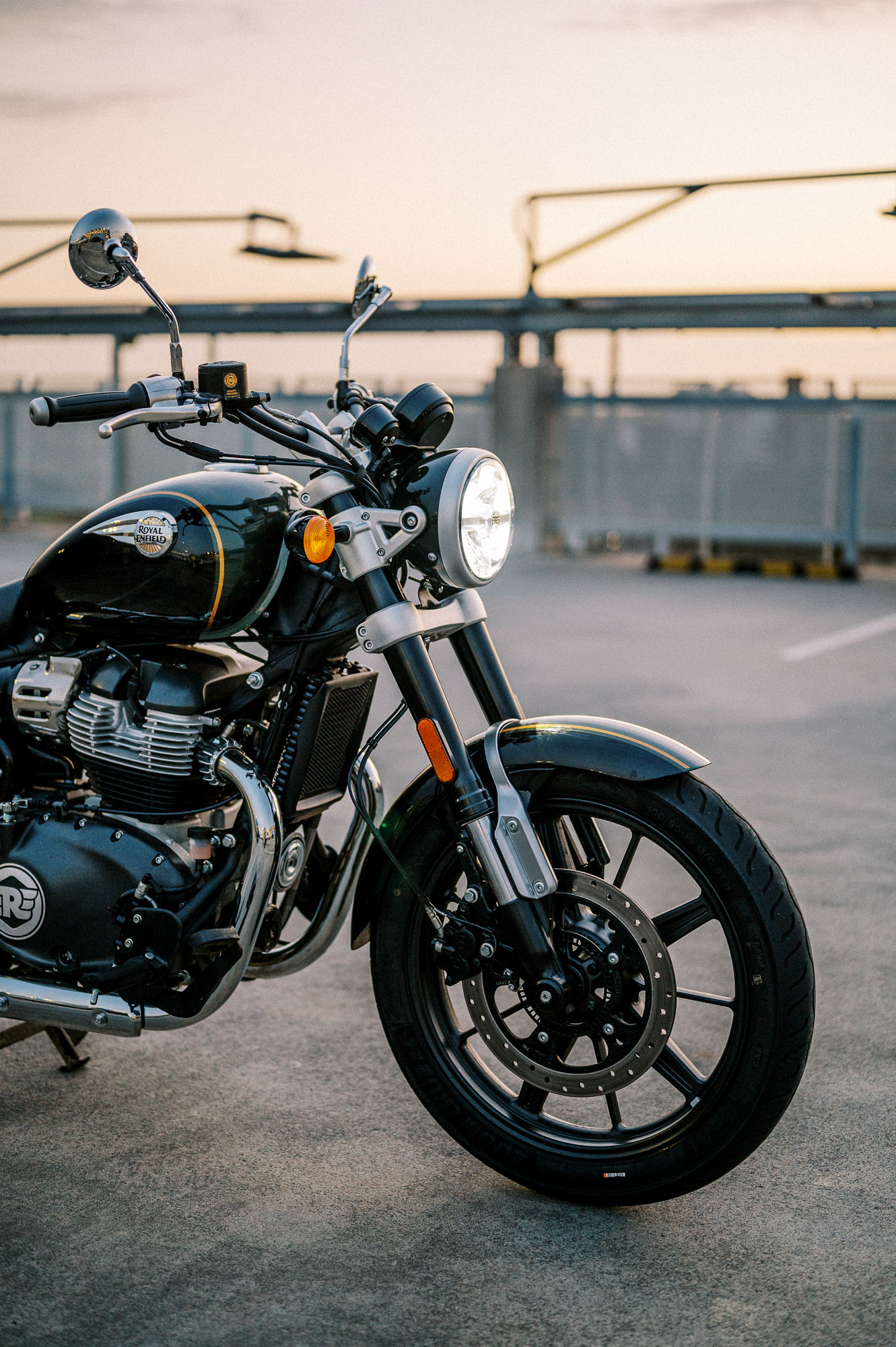
Final Thoughts on the 2023 Royal Enfield Super Meteor 650 Cruiser
So after all that blah, blah, blah, let’s clean off the whiteboard and summarise. Royal Enfield have made plenty of cruisers before – including ones for Indian Motorcycles in the ‘60s, and for themselves in the shape of the Lightning and Thunderbird. Thinking that this is a new turn for them would be way wrong. And from that filing cabinet of past designs, they’ve managed to pull something that’s genuinely impressive. The fact that it throws some shade on the previous 650 Twins in terms of build quality, specs and detailing should be more than enough that the company is aiming very high and is determined to get there.
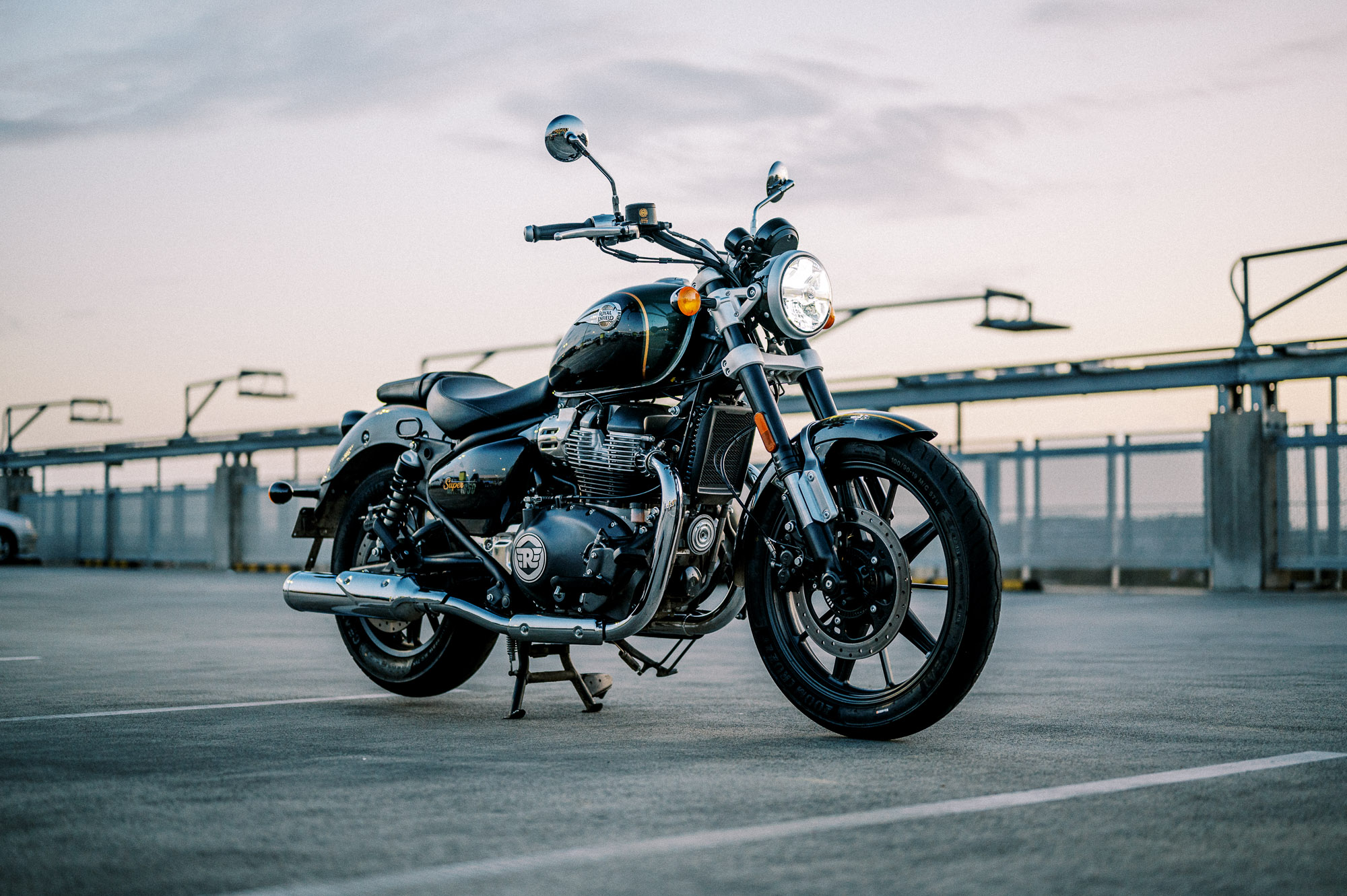
Riders expecting the Enfield to kick Harley’s arse or to blow the wheels off of a Triumph Bobber will be disappointed. Unless, of course, that Harley is a Street 500. Those who want a clean, pure riding experience and who don’t make buying decisions with their ego set to 10 will surely be impressed. This is a comfortable bike that is also very capable, handels well, looks great and while it’s very affordable, this also means that it’s delightfully gadget-free and will provide you with a unfussy, pure and very classic motorcycling experience without the oily driveway and the kickstarting frustrations.
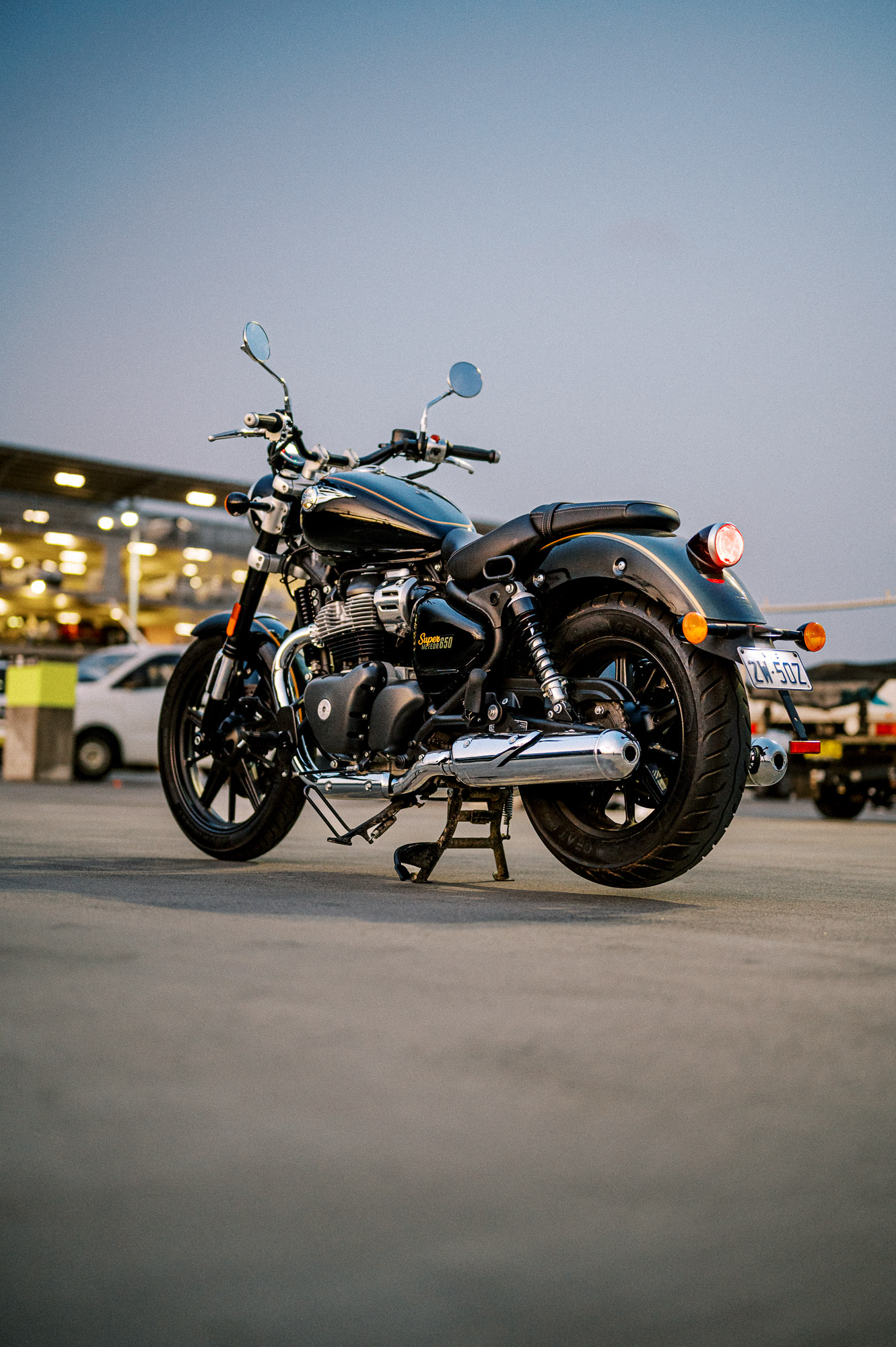
Yes, this bike is a winner. I’ve made a bold (and admittedly somewhat controversial) statement below that this bike just may be the best motorcycle Royal Enfield has ever produced. And no, I haven’t ridden the 1967 Super Continental Ensign Crusader Bullet 750 Twin thingy, Mr Opinionated Old Royal Enfield Encyclopedia man. But thinking about modern times and what technology has brought to the tables since then, I’d be more than willing to shout you a beer if you could prove me wrong. But you want to know what’s really exciting? It’s what the company is going to do and the bikes they are planning to release over the next five years. Because what I saw behind closed doors at the Tech Centre last year will make even giant steps like the Super Meteor you see here seem like they are just getting started. We can’t wait to ride them either.
2023 Royal Enfield Super Meteor 650 Cruiser at a Glance
General Info
|
Main Specs
|
Competitors
|
Pros
- Arguably the best Royal Enfield ever made
- Beautifully understated retro design
- Clean and functional
- Surprisingly good at corners
Cons
- Heavier than you might expect
- Not the quickest or most powerful cruiser out there
- Rear shocks can feel overly stiff across low speed bumps and road joints


